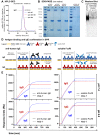Human IgE does not bind to human FcRn
- PMID: 34996950
- PMCID: PMC8741920
- DOI: 10.1038/s41598-021-03852-1
Human IgE does not bind to human FcRn
Abstract
The neonatal Fc receptor (FcRn) is known to mediate placental transfer of IgG from mother to unborn. IgE is widely known for triggering immune responses to environmental antigens. Recent evidence suggests FcRn-mediated transplacental passage of IgE during pregnancy. However, direct interaction of FcRn and IgE was not investigated. Here, we compared binding of human IgE and IgG variants to recombinant soluble human FcRn with β2-microglobulin (sFcRn) in surface plasmon resonance (SPR) at pH 7.4 and pH 6.0. No interaction was found between human IgE and human sFcRn. These results imply that FcRn can only transport IgE indirectly, and thereby possibly transfer allergenic sensitivity from mother to fetus.
© 2022. The Author(s).
Conflict of interest statement
The work of MB and EK was funded by argenx. GV serves as a consultant to argenx. The remaining authors declare no conflict of interests.
Figures


References
-
- Vidarsson G, et al. FcRn: An IgG receptor on phagocytes with a novel role in phagocytosis. Blood. 2006;108:3573–3579. - PubMed
-
- Christianson GJ, et al. Beta 2-microglobulin-deficient mice are protected from hypergammaglobulinemia and have defective antibody responses because of increased IgG catabolism. J. Immunol. 1997;159:4781–4792. - PubMed
Publication types
MeSH terms
Substances
LinkOut - more resources
Full Text Sources
Research Materials
Miscellaneous

